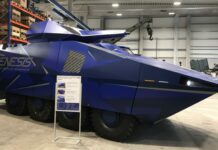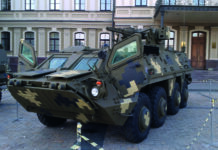Decrease in fuel requirements for military equipment on the battlefield is one of the arguments in favour of using electric motors or hybrid power plants in the near future. In addition, electric motors are quieter than internal combustion engines, which reduces the audibility of approaching vehicles and their detection in the infrared range.
In a military environment, the delivery of fuel under enemy fire can often lead to casualties among the soldiers involved. A high number of US and other NATO soldiers were attacked while delivering fuel in Iraq and Afghanistan. However, any confrontation with an opponent such as Russia, which operates long-range missiles, poses an even greater threat to the security of convoys.
Development Programmes
Today, no one knows for sure when the leading armies of the world will be implementing electric traction in their armoured vehicles. The development of electric transmissions began in the 1980s, and the interest in this development continued into the 1990s. However, projects of this nature failed to make any progress due to the lack of technological development.
The Armored Systems Modernization (ASM) programme of the US Army lasted from the mid-1980s into the 1990s. Under this programme, Kaman Electromagnetics, in collaboration with Allison Transmission (a General Motors department), together with Teledyne Vehicle Systems, developed an electric transmission for a 50-tonne tracked vehicle. At that time, the Army planned to modernise its armoured family of vehicles with a common chassis and modular components. This principle was supposed to reduce the costs of maintenance but since that time, costs of development and production were deemed too high. The Teledyne design made it possible to create a prototype for further testing of new elements in heavy armoured vehicles. The General Electric LV-100 gas-turbine engine with 1,235 hp was developed under the Advanced Integrated Propulsion System (AIPS) programme of the US Army, and the Kaman transmission generator converted mechanical energy into electrical energy.
During the tests, the advantage of the electric transmission was demonstrated, when electric energy was transmitted not only to traction motors, but also to the systems of protection against nuclear and chemical agents, and to the active protection power supply and the turret. At that time, the electric motors and generator were quite compact, but the electric transmission control systems have remained cumbersome.
In addition to the Kaman transmission, the United Defense Company was developing an alternative solution with asynchronous traction motors. Each of the options had its disadvantages; however, the simplicity and the ability to develop high levels of torque made it possible to consider the most suitable for creating electric transmissions for tracked vehicles.
Furthermore, the United Defense Company was carrying out work with a hybrid drive in the M113 Armoured Personnel Carrier. The portable battery power supply created an alternative to the engine as a source of energy. Such a hybrid drive provided the possibility of covert movement for short distances with the main engine shut off, depending on the capacity of the batteries.
Research in the field of electric drives in the 1990s was also carried out in France for the French Ministry of Defence. The CS-Defense Company, along with Panhard, worked on the electric drive for a 15-tonne armoured vehicle with a 6×6 wheel arrangement.
The development of electric transmissions was also carried out in Japan by Mitsubishi.
The Electric Motor
Today, it is too early to talk about the widespread introduction of electric motors for military equipment. However, experts are expecting a quantum leap in these activities over the coming decade. As we can see, the whole idea of an electric motor and transmission is nothing new, and many private companies are already implementing innovations in this area. Many private defence companies have also developed armoured vehicles with an electric or hybrid power plant. The global market for electric drives is changing as their efficiency is improving.
One factor to consider here is the rapid growth of electric vehicles in the civilian sector. Today, an increasing number of countries are planning to move away from using internal combustion engines within a few decades. And this trend has created a precedent when new technologies are first introduced in the civilian sector on a large scale, and are then transferred to the defence sector, and not vice versa. We should bear in mind that the introduction of an electric motor requires changes in the form of the armoured vehicles and the features of their use.
This implies the use of modern technology to improve the survivability, mobility and automation. Sensors in such a technique will be able to collect a huge amount of information about the environment and to process it with the help of artificial intelligence.
As a result, combat missions can be performed more efficiently and safely. Of course, outdated equipment will no longer be able to compete in many respects.
The electric engine underlies many changes and the introduction of new technologies. The electric engine for example, works better than the internal combustion engine in terms of controllability, starting speed, acceleration, and manoeuvrability of the equipment.
In this context, many mechanical parts required for the traditional propulsion system are being replaced by flexible cables, creating a large, redesigned space.
The replacement of many mechanical elements in the engine and shaft also creates the basis for the formation of a unified electronic system, which includes the power plant itself, control elements, necessary sensors, communication systems and the on-board computers.
Equipment Autonomy
All these components allow for greater autonomy of military equipment, as an intermediate element to smarter vehicles. The source of electricity will be used both for movement and for powering the electronic devices, sensors and electronics. Computers usually interact more organically with electrical than mechanical systems.
Mobility and manoeuvrability also contribute to the advantages of electric motors. Military vehicles can achieve faster speeds as each wheel can be independently controlled in terms of both grip and direction of rotation. Replacing the mechanical elements with lighter electrical systems allows for the optimisation of the armour. This is also due to the fact that the mechanical drive shaft is removed from the base of the combat vehicle which provides for better protection from explosive devices. In addition, electrical systems are easier to replace and upgrade compared to internal combustion engines and transmissions. Of course, the electric motor also offers lower fuel costs and improved fuel efficiency. The electric propulsion system provides a dramatically improved acceleration time than the internal combustion engine.
The hybrid electric drive system responds instantly to the need for movement by generating torque. This principle can be seen in electric vehicles, and it also applies to armoured vehicles. The ability of the electric motor to control the accuracy and direction of movement, together with computer systems, creates the basis for further integration with intelligent systems, including the creation of unmanned systems.
It is expected that the development of electric motors will provide for the improvement of related systems, namely the necessary sensors, batteries, and improved capabilities of artificial intelligence.
Batteries
Over the past decade, the cost of batteries has already dropped significantly. While their capacity has increased, the charging time has decreased, resulting in significantly enhanced performance. So, the assertion that Main Battle Tanks and other armoured vehicles of the future will run on electricity, or use a hybrid drive system in a transitional phase, is difficult to refute. Such a shift will not only reduce the demand for fuel in a war situation, but it will also reduce the risk to convoys transporting fuel to the front lines.
In modern conditions, the multi-tonne armoured vehicle requires a huge amount of energy to move over rough terrain, power fire control systems and sensors. Spare power for towing other tanks and armoured vehicles is also required. According to Global Security Review, the Army’s armoured division, with all its armoured vehicles and tanks, can consume up to 500,000 gallons of fuel a day when active and on the move, which is typically supplied from the continental part of the United States.
Accordingly, the transition to electric drive systems will significantly reduce the amount of fuel required in the combat zone. But this will not completely remove the need for energy; it will simply be generated in a different form. And this is still under discussion. According to the National Defense magazine, in 2004, the US Army expected their hybrid trucks to meet their stated goal of 75 per cent fuel savings by 2020.
At that time, according to the Defense Science Board, which advises the US Department of Defense, fuel accounted for about 70 per cent of the logistics tonnage in a heavy armoured division. And the cost of delivering a gallon of fuel to the battlefield was US$600.
The Oshkosh Truck Company expected that its hybrid-electric vehicle, the Heavy Expanded Mobility Tactical Truck (HEMTT) with the ProPulse system, would burn 40 per cent less fuel than a standard HEMTT, depending on the mission.
Despite the distinct advantage and effectiveness of hybrid installations, to date, however, they are still at the experimental stage, and as yet, have not been put into operation. For example, this deals with the possibility of installing a 1,000-hp Advanced Powertrain Demonstrator on the M2 BRADLEY, or on the new models of the controlled or robotised machinery.
Advanced Powertrain Demonstrator Initiative
The Advanced Powertrain Demonstrator (APD) initiative was launched in 2015 after the Army rejected the previous Ground Combat Vehicle programme. The main objective was to develop key technologies required for the creation of revolutionary platforms of the future. The APD consists of several components, including:
- an advanced combat engine
- a gearbox
- a built-in starter generator
- modular batteries
- a temperature management system
The built-in starter generator is actually an engine, which is another piece of key technology. It generates 160 kW of power, which is about ten times more than on the current medium combat vehicles. The large amount of power generated by the engine can be used to expand the capabilities of the platform, such as electrical armour and lasers, or it can be exported to power other systems.
According to the digital magazine Breaking Defense, the 1,000-hp Advanced Powertrain Demonstrator produces 48 per cent more horsepower than the most modernised BRADLEY variant and 67 per cent more than the standard 600-hp model. It is also compact enough to fit even into the BRADLEY.
The current Advanced Powertrain Demonstrator installed in the M2 BRADLEY for testing, can move military vehicles weighing up to 50 tonnes. The power created by the engine is crucially important for the modern combat vehicle. For example, during the war in Iraq, the outdated BRADLEYs were augmented with a large number of sensors, additional monitors, communications equipment, and radio jamming systems to deactivate explosive devices.
In modern conditions, the vast arsenal of the Russian RPGs and anti-tank missiles pose a serious threat and this triggers debates concerning the installation of active protection systems on armoured vehicles. Such systems include radars to detect artillery shells and the corresponding missile launchers to counter them. This also implies high energy consumption. They will later need the additional energy for the operation of the laser and microwave weapons, as well as for countering drones. By 2022, it is planned to integrate the Advanced Powertrain Demonstrator into the unmanned BRADLEY prototype, also referred to as the Advanced Mobility Experimental Prototype. Another logical nominee for APD technology is the Optionally Manned Fighting Vehicle, which is being developed to replace the BRADLEY.
Electric Motors in the Coming Years
In 2021, we observed some progress in terms of gradual introduction of electric motors into military armoured vehicles operated by the US Army. In all likelihood, heavy armoured vehicles will be the first to be equipped with a hybrid system. The hybrid electric drive systems use the energy accumulators of higher energy densities and capacities in order to power vehicle systems and to support the main engine during its peak performance such as during acceleration. In general, preparations for transition to electric motors in the US Army have already begun. The Army Futures Command made a request to Fort Benning, one of the largest military bases in the United States, for information on what is required to equip tactical and combat vehicles with electric motors.
According to a news release, the Manoeuvre Capabilities Development and Integration Directorate is currently drafting a document on the future requirements for the tactical and combat electrification of vehicles, the introduction of electric motors in the US Army’s ground forces, and reducing dependence on fossil fuels. According to information provided by Military.com, Lt. Gen. Eric Wesley, the deputy commander of Army Futures Command and director of the Futures and Concepts Centre, stated in April 2020 that the developers of the Tesla civilian vehicles in Palo Alto, California, have already proved that electric motor technology can be used to drive vehicles as large as the Joint Light Tactical Vehicle.
It seems that the Pentagon also believes in switching to electric traction power and batteries. Since 2009, a new diesel hybrid called the Clandestine Extended Range Vehicle (CERV) has been tested in the US Army. It is designed for short-term special operations such as reconnaissance, surveillance and targeting. It was noted that fuel economy would be a considerable advantage of this special vehicle. The vehicle was designed by the Quantum Fuel Systems Technologies Worldwide in cooperation with the US Army’s Tank Automotive Research, Development and Engineering Centre (TARDEC) National Automotive Centre.
In 2020, the US Army’s Rapid Capabilities and Critical Technologies Office (RCCTO) signed an agreement with BAE Systems for US$32M. Under this agreement, the Hybrid Electric Drive (HED) system is expected to be installed onto the BRADLEY. A key component of the HED system for the tracked combat vehicles is the cross drive transmission (Modular E-X-Drive) developed by QinetiQ. Such an integration should significantly improve the efficiency of the vehicles and provide the energy reserves for integration with future systems and technologies. Moreover, the Hybrid Electric Drive should significantly increase the mobility of the combat vehicle on the battlefield, and also its range, which significantly exceeds the existing operational capabilities of the BRADLEY IFV.
Due to slight modifications, the Hybrid Electric Drive technology can be installed on other combat vehicles, including the BRADLEY, the M109A7 self-propelled howitzer, and the family of Multiple Launch Rocket Systems.
Conclusion
According to trends in the US Army and defence companies concerning the introduction of electric and hybrid power plants, the question is not whether this will happen, but when, and in what form new models of armoured vehicles will take. Most likely, during this transition period, hybrid power plants will be introduced, since electric motors at this stage are not yet able to fully power the multi-tonne equipment on their own.These days, many companies have already expressed their readiness for further electrification of their armoured vehicles. Every year, armoured combat vehicles face an increasing need to confront new challenges, such as drones.
Further development of laser technology is also expected in the nearest future. This whole set will require more and more energy from the power plant for a longer period of time.
The civil electric vehicle market will also make its own adjustments, as the production of electric motors will gradually divert the industry, moving further away from the internal combustion engine. In addition, electric motors have a number of advantages that are applicable specifically under combat conditions, such as quieter operation when moving, ease of maintenance due to fewer mechanical parts.
This technology can also increase the range of vehicles. It should also be taken into account that if hybrid installations are already applicable today, then with fully electric equipment, the question regarding the source of recharging during combat missions, far from support bases, remains unresolved. However, according to the experts, this issue can be resolved in the upcoming decades.












